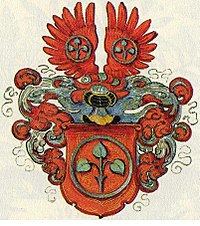Schilling (Silesian noble family)
The Schilling were a noble family in Silesia and Poland originally from Alsace . The family, which is believed to have died out, belonged to the patriciate in Wroclaw and Cracow and was a member of the councilors.
history
Origin and coat of arms
The progenitor of the family is Friedrich Schilling, who was a judge in Weißenburg around 1452 . Married to a Barbara Stahl, it suggests that he was the son of Bernhard Schilling von Surburg , who owned his property in Beinheim next to the Stahl family who had been resident in Weißenburg for a long time. The Schillings from Surburg, in turn, are probably a branch of the patrician family of the same name from Basel , other sources attribute them to the schillings from the Lower and Middle Rhine or even to both sexes.
The family had a three-fold linden leaf as a coat of arms in red in a white circle , whereas in Bernhard Hertzog's chronicle only a single linden leaf is depicted.
First generation in Silesia
The sons of the Weißenburg magistrate, Friedrich II., Johann, Nikolaus and Jodokus were nationally active merchants who organized a branch system for their trade between their hometown and Krakow. Between 1473 and 1513 the brothers finally moved to Cracow, following a general trend of the time.
The flourishing trading business with branches in Wroclaw, Leipzig and Nuremberg gave the brothers prosperity and prestige. Frederick II was already a member of the Krakow council in 1490 and is considered the founder of the Polish paper industry thanks to his financing of the first paper mill in Poland . The brothers were also active in the field of culture, so in 1507 orders were awarded to Albrecht Dürer , who designed a lunette for a family chapel donated in Weissenburg around 1510 , which has been preserved in the British Museum in London.
In 1507 the family was finally raised to the nobility.
Another story
While part of the family stayed in Krakow and another moved to Poznan , one of Friedrich II's sons, Daniel (1506 to 1563), went to Wroclaw, where he successfully continued his father's trade as a cloth merchant and in the sale of land. The line that flourished until 1677 descends from him and, by marriage to the most respected Wroclaw families, left its mark on the economy and city politics. His artistically significant epitaph has been preserved from Daniel himself in the Elisabeth Church, which depicts him as a living person as well as an unclothed dead person. Among his descendants, Friedrich von Schilling (1584 to 1637), who held influential offices at the court of Ludwig I, Prince of Anhalt-Köthen, was one of the organizers of the Fruitful Society . In 1543 the entire family received Polish recognition of their nobility and has belonged to the Szlachta ever since .
Finale
When exactly the family went out is not known with certainty. In 1710, a Heimard Johann von Schilling, a margravial colonel from Baden , received an increase in rank, who according to the coat of arms belonged to that family. In 1729 a Christian Ludwig Schilling, civil servant in Dresden, applied for the recognition of the nobility and the use of the coat of arms, which was also granted. In fact, his descendants still bear that coat of arms today. In 1868 the Viennese writer August Schilling took up the tradition of the Silesians at the award ceremony and from then on called himself "Knight of Henrichau " and carried the slightly changed coat of arms of the same. The Schilling-Siengalewicz family, based in the Poznan area , also had this coat of arms. However, the genealogies of the named persons and families, with the exception of Heimard Johann, are rather dubious or cannot be checked in more detail.
literature
- Bernhard Hertzog : CHRONICON ALSATIAE. Edelsasser Cronick and a detailed description of the western Alsace on the Rhine river. , Jobin, Strasbourg, 1592
- Schilling, gender. In: Johann Heinrich Zedler : Large complete universal lexicon of all sciences and arts . Volume 34, Leipzig 1742, column 1566–1574.
- Ernst Heinrich Kneschke : New general German nobility lexicon , Volume 8. Friedrich Voigt's bookstore, Leipzig 1868
- Heinar Schilling: The lineage of the Eriks family. Part I: The Western Tribe 1198-1948. Glücksburg 1948
- Oskar Pusch (genealogist) : The Breslauer Rats- und Stadtgeschölker in the period from 1241 to 1741 (publication of the Research Center East Central Europe at the University of Dortmund, series B), Volume IV, Dortmund, 1990, ISBN 3-923293-26-7 ,
Web links
Individual evidence
- ↑ Bernard Hertzog: chronicon Alsatiae. Edelsasser Cronick and a detailed description of the western Alsace on the Rhine river. , Jobin, Strasbourg, 1592, p. 210
- ↑ Baden Historical Commission (ed.): Regesten der Margrrafen von Baden and Hachberg (1050 - 1515) , Wagner, Baden 1915, Volume 4, Page 20
- ↑ u. a. Heinar Schilling : The lineage of the Eriks family , self-published by Glücksburg, 1948
- ↑ So u. a. formulated in the increase in rank and improvement of the coat of arms for Schilling, Raphael, Freiherr von, imperial major general and chamberlain, count, high and well-born, 1781, preserved in the Vienna aristocratic archives, signature AT-OeStA / AVA Adel RAA 370.14
- ↑ See as evidence u. a. Saxon State Archives, 10005 Court and Central Administration (Wittenberg Archives), No. Loc. 4373/05, p. 002
- ^ Oskar Pusch : The Breslauer Rats- und Stadtgeschölker in the period from 1241 to 1741 (publication by the Research Center for East Central Europe at the University of Dortmund, series B), Dortmund, 1990, ISBN 3-923293-26-7 , page 105
- ↑ Copy of the diploma in the Vienna aristocratic archives, signature AT-OeStA / AVA Adel RAA 370.11
- ↑ See Adelsarchiv Wien, signature AT-OeStA / AVA Adel RAA 370.10
- ↑ See Adelsarchiv Wien, signature AT-OeStA / AVA Adel RAA 370.11

